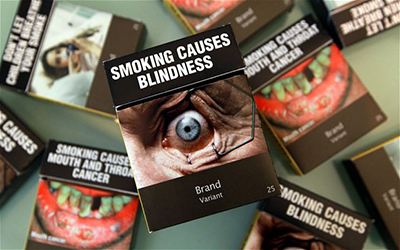
Source: www.trendingcentral.com
Current evidence indicates that health warnings combined with coloured photographs; i.e. pictorial health warnings (PHW) are an effective means of discouraging smoking. This is done by provoking more thought about the health risks of tobacco use, increase motivation and intention to quit and are associated with more attempts to quit. PHW also disrupt the impact of brand imagery and decrease the overall attractiveness of the package, therefore affecting uptake of smoking by ALL, including vulnerable groups: – women, children and youth. In addition, PHWs have the potential to reach people with low levels of literacy.
The Ministry of Health Malaysia fully implemented six PHWs in June 2009. The Global Adult Tobacco Survey (GATS), Malaysia in 2011 reported that 92.8% of current smokers (93.2% of men, 74.7% of women) had noticed the health warnings on the cigarette packages, however, only 45.8% of these current smokers had thought about quitting because of these labels.
A policy brief was prepared to determine on methods to improve the effectiveness of health warnings on cigarette packages. From systematic review and primary research, three options were identified to address the issue.
Option 1 – Change the graphic of the PHWs
This option suggests changing the existing PHWs to a new set with a bigger size, more impactful pictures, clear health messages and the addition of quit line information. In addition,to ban the use of colours and features on the cigarette packs that specifically targeting vulnerable groups, such as women, youth and children. This option will help to improve the impact of PHWs on reducing uptake and increasing cessation of tobacco products. The advantages of Option 1 include bolstering the overall message of health warnings, reduce false belief about risks, promote cessation, reduce appeal and purchase intent as well as susceptibility to smoking.
Option 2 – Introduce plain packaging for cigarettes
The global growing burden of smoking has prompted the introduction of plain packaging in order to reduce the promotional impact of cigarette packaging. Thus Option 2 suggests improving the impact of PHW by decreasing the attractiveness of the cigarette packages through introducing plain packaging for cigarettes. The advantages of plain packaging are: enhance salience of health warnings; reduce misperceptions about the relative harmfulness of different brands; reduce misperceptions about the relative harmfulness of different brands; reduce susceptibility to smoking; reduce purchase intent and promote smoking cessation.
Option 3 – Printing of text health warning messages on every stick of cigarette
Option 3 will ensure text health messages to be read by smokers even without the packages. Therefore it is suggested to mandate the printing of specific message on every stick of cigarette; e.g. “Merokok membahayakan kesihatan”. These measures will help to expose smokers to the text health messages whenever they light up a stick of cigarette, which will also visibly differentiate duty-paid cigarettes from contraband cigarettes to enhance detection by our enforcement officers. The advantages of printing text health warning messages on every stick of cigarette are: visibly differentiate duty-paid cigarettes from contraband cigarettes; enable enforcement action to be taken on the consumers by our enforcement officers; reduce illicit cigarette and warn the smokers on the danger of smoking.
Implementation of the three options above would likely to garner strong support from non-government organisations and consumer groups. On the other hand, there would have barriers in implementing either one of the options such as resistance from the tobacco industries; which are linked to cost, less brand appealing, reducing sales of cigarettes and thus decreasing profit for the industries.
This article hopes to educate the public on current efforts by Malaysia to reduce its tobacco smoking prevalence as a signatory of the framework Convention on Tobacco Control (FCTC). The public should expect policy makers to mandate strong pictorial health warning legislation to promote cessation and implement smoke-free law in combination with graphic cigarette warning labels. Ultimately it is hoped that Malaysia will step together with countries such as Brunei, Thailand, Singapore and Australiathroughadvocating the public that plain packaging would discourage the younger generation from smoking via information campaign in media targeting communities.
Ms. Helen Tee Guat Hiong and Dr. Tahir Aris are researchers from Institute for Public Health, Ministry of Health Malaysia. Ms Helen is the primary investigator for the preparation of the policy brief on “Improving the Effectiveness of Health Warnings on Cigarette Packages”. Ms Helen is also a member of the NARCC.
[This article belongs to The Malaysian Medical Gazette. Any republication (online or offline) without written permission from The Malaysian Medical Gazette is prohibited.]
